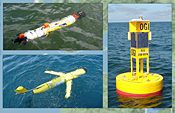Cruise Plan & Minutes
Goals:
Bill, Joseph, Nick, Solomon: Find the ETM by obtaining a series of casts that show the "salt wedge" advancing or retreating, while the bottom turbidity increases and then decreases.
Suzanna & Kira: Collect a sample in this ETM, or as near as possible.
Lydie & Peter: Collect samples in "fresh" (<1 psu) and "salt" (>30 psu) water.
Planning
Wednesday 6/13, 4:00 pm: Planning meeting. Forecast for next day was not available, so we made initial predictions based on a previous day with similar river discharge levels. Tentatively decided on an starting location (where we expect the tip of the "salt wedge" to be) of 46°11.8', -123°50.5'. Lydie's goals were relatively easy to meet, so we agreed to first take a fresh water sample, then search for the ETM, and last travel out near the mouth for a salt water sample.
Thursday 6/14, 7:00 am: Reviewed day's forecast, which predicted a much smaller salt intrusion than expected. Joseph said nothing changed in the river forcings, so it must have been a result of slightly different timings of the tides. Established a new starting location of 46°11.4', -123°54.68'. Flood tide was to last until 2:30 PM, so if this starting location had a low bottom salinity as expected, we would remain at the location as the salt wedge (and the ETM) advanced past us.
Cruise Minutes
7:30 am: Left for Astoria, later than planned.
8:00 am: Low tide.
9:45 am: Arrived at Clackamas Community College docks.
10:30 am: Departed docks (later than planned).
10:49 am: Arrived at station 1, made four casts. Bottom salinity remained less than 0.2 psu, so Lydie collected her fresh water samples.
11:54 am: Arrived at station 2, the "old" starting location from Wednesday. Took a cast to be conservative, in case the most recent forecasts under-predicted the salt intrusion. Bottom salinity still was only 0.44.
12:16 pm: Arrived at station 3, the starting location from the most recent forecasts. For the first cast, salinity was 2-3 psu for the entire water column, indicating well-mixed waters rather than the expected salt wedge. Salinity was too high for the edge of the salt wedge, but the top and bottom salinity were very similar, showing no such wedge. Bill suspected the real salt wedge was further downstream, and Suzanna showed microbiology papers indicating that the ETM had been found at a higher salinity. Decided to remain on location since there was a flood tide.
1:03 pm: Still at station 3. A "foot" appeared in the salinity/temperature, showing a sharp gradient. Top salinity at 2 psu while bottom at 12 psu. Took more casts and samples each time for Suzanna. Turbidity increased until 1:33, then decreased. Salinity continued to increase. After 11 casts, sailed toward the mouth.
2:24 pm: Arrived at station 4 to take a salt water sample for Lydie. Bottom salinity only 28.4; decided to sail closer to the mouth. Interface between tides and river water visible as a line separating distinct colors.
2:30 pm: High tide.
2:43 pm: Arrived at a very wavy station 5. Took three casts and samples; bottom salinity ranged between 30.0 and 32.2. Turned back towards dock.
3:40 pm: Arrived at station 3 again. Took two more casts. Salinity even higher (25-26) and turbidity still low.
4:50 pm: Arrived back at Tongue Point dock.






